
1
Kalgoorlie Super Pit 1
For more than 100 years the mines of the Kalgoorlie Goldfields have produced the majority of Australia's Golden wealth. For more details please visit: -- http://www.kalgoorlie.com/tourism/goldenmile.asp
| 
2
Kalgoorlie Super Pit 2
The massive Super Pit, Australia's largest open cut gold mine, was established in 1989 and was the brainchild of Alan Bond.
| 
3
Kalgoorlie Super Pit 3
Western Australia supplies 75% of Australia's total gold production and about 8% of the world's gold production.
|

4
The Birth of the Super Pit
Alan Bond saw the need for a Super Pit, so he started it by buying up all the small leases that had been separately owned for nearly a centuary. It was then possible to operate a gigantic and ever-descending Super Pit in which massive equipment could tear out the old underground workings and unmined gold in between.
| 
5
Panorama of Super Pit
Stitched Panorama of the first three photos to give a wider view of a section of the Kalgoorlie Super Pit.
| 
6
Super Pit Kalgoorlie
The Super Pit will eventually stretch 3.8 km long, 1.35 km wide, and go down to a depth of more than 500 metres. In 1989 the entire area was combined and Kalgoorlie Consolidated Gold Mines Pty Ltd formed to manage assets and operations.
|

7
Kalgoorlie Super Pit 4
Another section of the Super Pit. It takes seven 220-tonne truckloads of rock to produce a tiny two-ounce nugget. More than 50,000,000 ounces of gold have already been mined on the Golden Mile.
| 
8
Kalgoorlie Super Pit 5
About 85 million tonnes of ore and waste are removed per year - that's 232,000 tonnes per day.
| 
9
Panorama of Super Pit
Stitched Panorama of Super Pit photos.
|

10
Mine Machinery
Huge Machines used in the Super Pit at Kalgoorlie.
| 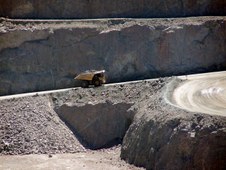
11
Loaded Haulpak Ascending
Loaded Haulpak ascending the long slopes of the Super Pit at Kalgoorlie. Ore carrying trucks used at the Super Pit are the biggest of their type in use in an Australian gold mine. The new Caterpillar 793Cs cost $4 million each. They weigh a massive 376 tonnes and are 6.4 metres high and 7.4m wide. They travel at a top speed of 54.3kmh and carry 220 tonnes of ore in one load. Each tyre costs $26,000 to replace.
| 
12
Empty Haulpak Descending
Haulpak Descending the long slopes of the Super Pit at Kalgoorlie. The Super Pit's mine life is estimated at a further 16 years. At that time the size of the pit will be approximately 3.8km long, 2km wide and 500m deep and more than 17,000,000 ounces of gold will have been extracted.
|
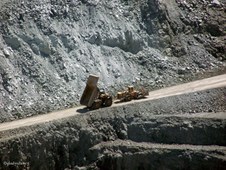
13
Broken Down Haulpak
This Haulpak appeared to be broken down and was being Towed out of the Super Pit at Kalgoorlie.
| 
14
Dust Control
An important development that occurred with the shift from underground to open pit mining, and the proximity of communities to mine operations, has been the mining industry's focus on sound environmental practices. This has resulted in mining companies conducting regular noise surveys, dust sampling, monitoring of air quality and the introduction of major revegetation programs such as KCGM's award winning Greening the Golden Mile initiative.
| 
15
Kalgoorlie Super Pit 6
Zoomed across to some of the many levels of the Kalgoorlie Super Pit. The Huge Haulpak at the top still looks small.
|

16
Kalgoorlie History 1
| 
17
Kalgoorlie History 2
| 
18
Kalgoorlie History 3
|

19
Kalgoorlie Super Pit 7
A few of the levels of the Kalgoorlie Super Pit where the Huge Machines look very small.
| 
20
Paddy Hannan Statue
In 1893 Paddy Hannan, Tom Flanagan and Daniel Shea discovered alluvial gold nuggets near Mount Charlotte when they were forced to camp out unexpectedly after their horse lost a shoe. On 17 June 1893 Paddy Hannan registered his claim and, within three days, an estimated 700 men were prospecting in the area. This was the goldrush to beat all goldrushes. His memorial sits in heavy shade in Kalgoorlie.
| 
21
History of St Barbara
Saint Barbara is the Patron Saint of the Mining and Resources Industry.
|

22
Main Street of Kalgoorlie
The Streets were made very wide to accommodate the Camel Trains in the Goldrush Days. Now the Street has been divided by an Island in the middle with two lanes of Traffic and Parking each side.
| 
23
Town Hall Kalgoorlie
| 
24
York Hotel Kalgoorlie
Unusual Architecture of the York Hotel at Kalgoorlie. Note the Wedge Tailed Eagle soaring above.
|

25
Post Office Kalgoorlie
| 
26
Public Buildings Kalgoorlie
| 
27
Warden's Court Kalgoorlie
|
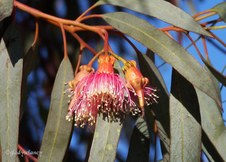
28
Coolgardie Gum
Coral Gum (Eucalyptus torquata) at Coolgardie.
| 
29
Coolgardie Gum
Coral Gum (Eucalyptus torquata) at Coolgardie.
| 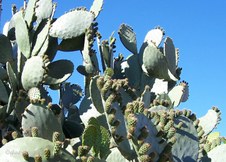
30
Prickly Pear
An introduced species at Coolgardie.
|

31
Historic Coolgardie Buildings
Return visit to Coolgardie on way to Victoria Rock Nature Reserve.
| 
32
Paddy Hannan Slept Here!
It is claimed that Paddy Hannan Slept Here in Coolgardie!!
| 
33
Coolgardie Gum
Flowers and Buds of Coral Gum (Eucalyptus torquata).
|

34
Coolgardie Gum
Coral Gum (Eucalyptus torquata).
| 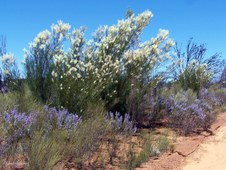
35
Roadside Flora
| 
36
Tinsel Flower
Cyanostegia angustifolia.
|

37
White Plumed Grevillea
Grevillea pterosperma.
| 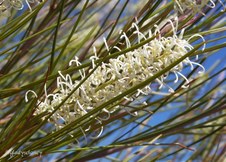
38
White Plumed Grevillea
Grevillea pterosperma.
| 
39
Yellow Popflower
Glischrocaryon aureum.
|

40
Tinsel Flower
Cyanostegia angustifolia.
| 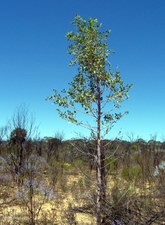
41
Desert Poplar
Codonocarpus cotinifolius.
| 
42
Roadside Wildflowers
|

43
Solanum
| 
44
Nature's Floral Display
| 
45
Blue Dampiera
Dampiera linearis.
|

46
Blue Dampiera
Dampiera linearis.
| 
47
Pink Spike Hakea
Hakea coriacea.
| 
48
Pink Spike Hakea
Hakea coriacea.
|

49
Blue Dampiera
Dampiera linearis.
| 
50
Victoria Rock
One of the Goldfield's most spectacular natural granite outcrops can be seen at Victoria Rock Nature Reserve 43 km south of Coolgardie.
| 
51
Victoria Rock View
The surrounding woodland viewed from Victoria Rock was clear-felled for its timber in the 1920's. The Woodland now seen is regrowth, consisting of Salmon Gum, Gimlet and Redwood. Closer to the rock, thickets of Rock Sheoak and Mallee York Gum.
|

52
On Victoria Rock
A Rock Pool and Vegetation on Victoria Rock.
| 
53
Rock Pool
Rock Pool at noon on Victoria Rock.
| 
54
Tadpoles in Pool
|

55
Rock Ferns
Delicate Rock Ferns grow near the pools on Victoria Rock.
| 
56
Vegetation on Rock
| 
57
Yellow Schoenia
Yellow Schoenia makes a colourful display at Victoria Rock.
|

58
On top of Victoria Rock
| 
59
On Victoria Rock
Wildlife of Victoria Rock includes ornate dragons (small lizards), emus, echidnas and frogs.
| 
60
On Victoria Rock
The abundance of Wildflowers provides an excellent food source for the variety of birds in the area, which include honey eaters, yellow-throated miners and rainbow bee-eaters.
|

61
Victoria Rock
| 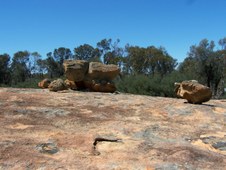
62
Boulders on Victoria Rock
Nestled beside the rock are several secluded picnic and camping sites catering for visitors.
| 
63
Roadside Stop
Roadside Stop between Victoria Rock and Hyden. The tall trees are Desert Poplars.
|

64
Grasstrees
| 
65
Native Pomegranate
Balaustion pulcherrimum.
| 
66
Mauve Featherflower
Verticordia.
|

67
Grasstree
| 
68
Grasstree Flower Spike
| 
69
Section of Grasstree Trunk
|

70
Silver Goodenia
Goodenia affinis.
| 
71
White Cypress Pine
Callitris glaucophylla.
| 
72
Wildflowers in Blue
|

73
Wattle (Acacia)
| 
74
Grasstree
| 
75
Yellow Plumes
|

76
Spinifex
| 
77
Blue Goodenia
Goodenia caerulea.
| 
78
Bushfire Regrowth
Regrowth appearing after a Bushfire last Summer.
|

79
Bushfire Regrowth
Nature making a recovery.
| 
80
Bushfire Regrowth
Slowly recovering with new growth.
| 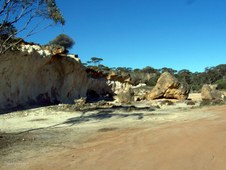
81
The Breakaways
Arriving at The Breakaways east of Hyden in the late afternoon.
|

82
At The Breakaways
| 
83
Afternoon Tea
Time for a late afternoon tea on a picnic table provided in a secluded spot in the Breakaways.
| 
84
The Breakaways
The golden glow of a piece of hard horizontal surface rock sticking out above the weathered soft under layer.
|

85
The Breakaways
Although in the Shadows, this shows the colours of the weathered under layer of this lovely but fragile stopping place.
| 
86
The Breakaways
Breakaways, those lines of hard capped and colour filled cliffs bounding flat-topped tablelands, are a notable feature of inland Western Australia.
| 
87
The Breakaways
In what is one of the oldest geological regions on earth, the so-called Yilgarn Block, soil types of any softness have gradually eroded through the ceaseless action of wind and water. Only those areas with a hard laterite (ironstone/granite) top have resisted this grinding and reshaping.
|

88
The Breakaways
The magnificent colours so often seen in these cliffs are a consequence of varying soil types, with lateritic types giving rusty reds and shales and sandstones the softer yellows and whites.
| 
89
The Breakaways
Where the crust of these laterite layers has crumbled the hard top remains to form a Mesa, while the continuing erosion of the softer soil and rock forms a steep Breakaway.
| 
90
Colourful Pigface
Disphyma crassifolium at base of Rocks at The Breakaways.
|